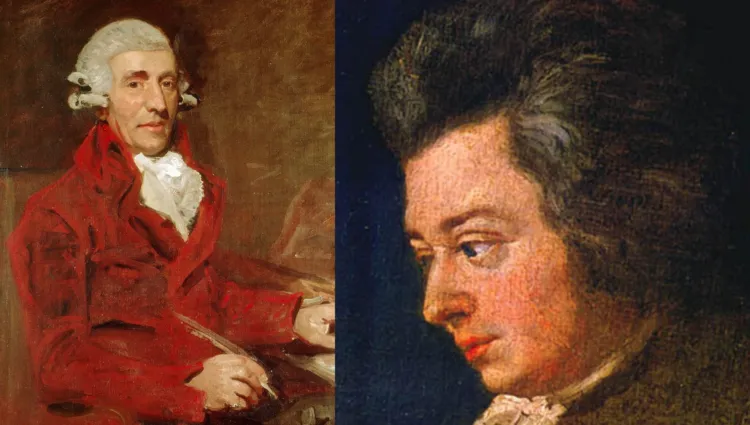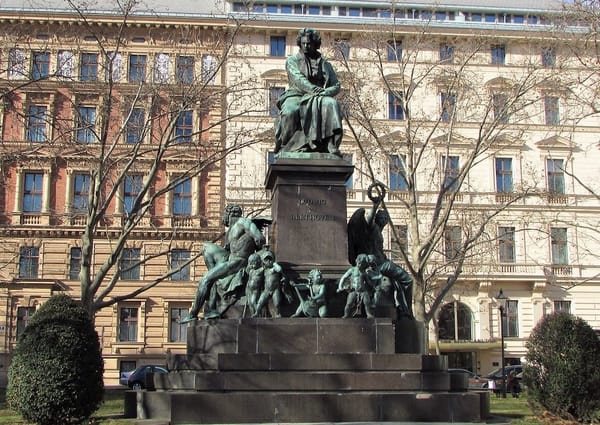The Friendship of Mozart and Haydn: A Harmony of Geniuses

The world of classical music has been profoundly shaped by many extraordinary composers, but few relationships within this sphere are as captivating as the friendship between Wolfgang Amadeus Mozart and Joseph Haydn. These two titans of classical music, separated by nearly a quarter of a century in age, shared a mutual respect and admiration that transcended their differences and culminated in one of the most remarkable friendships in music history.
Early Lives and Backgrounds
Joseph Haydn, born in 1732 in the small Austrian village of Rohrau, emerged from humble beginnings. The son of a wheelwright and a cook, Haydn showed an early talent for music, which led him to Vienna as a choirboy at St. Stephen’s Cathedral. Despite the financial and social hardships he faced, Haydn’s prodigious talent and relentless work ethic propelled him to the position of Kapellmeister at the Esterházy court, where he gained substantial recognition for his symphonies, string quartets, and operas. His position at the court provided him with the stability and resources to experiment and refine his craft, earning him the title “Father of the Symphony” and “Father of the String Quartet.”
Wolfgang Amadeus Mozart, on the other hand, was born in 1756 in Salzburg, into a musical family. His father, Leopold Mozart, was a prominent composer and music teacher, and young Wolfgang was a child prodigy. By the age of five, he was already composing music, and his early years were marked by extensive tours across Europe, showcasing his exceptional talents. Despite his prodigious gifts and early fame, Mozart’s career was fraught with financial instability and professional frustrations, largely due to his struggles with securing stable patronage and his volatile personality.
The Genesis of a Friendship
The paths of these two musical giants crossed in Vienna, where Mozart moved in 1781, seeking greater artistic freedom and opportunities. At this time, Haydn was already an established figure in the Viennese music scene. Despite their age difference—Haydn was 24 years Mozart’s senior—their friendship blossomed through their mutual admiration for each other’s work.
Their first documented meeting likely took place in the early 1780s. Haydn, who had returned from his second successful trip to London, attended one of the many musical gatherings held in Vienna. It was during these gatherings, often referred to as “musical academies,” that the two composers played together and shared their compositions. Mozart and Haydn quickly recognized each other’s genius. Haydn was reportedly astonished by Mozart’s extraordinary abilities, both as a composer and a performer, while Mozart deeply respected Haydn’s mastery of form and expression.
Musical Exchange and Mutual Influence
One of the most significant aspects of their friendship was the profound influence they had on each other’s music. Haydn’s work, especially his string quartets, inspired Mozart to compose his own set of six string quartets, known as the “Haydn Quartets” (K. 387, 421, 428, 458, 464, and 465). Dedicated to Haydn, these quartets are considered some of Mozart’s finest chamber works, showcasing his growth as a composer and his ability to blend his melodic brilliance with Haydn’s structural clarity and sophistication.
In turn, Mozart’s innovative spirit and technical prowess spurred Haydn to push the boundaries of his own compositions. Haydn once remarked, “Posterity will not see such a talent again in 100 years,” highlighting his high regard for Mozart’s unique genius. Their mutual respect is evident in the way they incorporated elements of each other’s styles into their works, leading to a rich cross-pollination of ideas that benefited both composers and enriched the classical repertoire.
Personal Affection and Professional Support
Beyond their professional admiration, Mozart and Haydn shared a deep personal bond. They frequently visited each other, played music together, and enjoyed each other’s company. Haydn, who was childless, treated Mozart almost like a son, providing him with guidance and support. Mozart, in turn, held Haydn in the highest esteem, often referring to him as “Papa Haydn.”
One of the most touching aspects of their friendship was Haydn’s unwavering support for Mozart, especially during the latter’s difficult times. When Mozart’s financial situation became dire, Haydn offered him moral and, at times, financial support. This generosity extended to Mozart’s family as well; after Mozart’s death in 1791, Haydn continued to support Constanze Mozart and her children.
The Famous Quartets: A Testament to Friendship
The dedication of Mozart’s six string quartets to Haydn is perhaps the most enduring testament to their friendship. In the preface to the quartets, Mozart wrote a heartfelt dedication to Haydn, expressing his gratitude and admiration. He acknowledged Haydn as a master and confessed that he had labored hard over the quartets to meet Haydn’s high standards. This dedication not only underscores the profound influence Haydn had on Mozart but also highlights the deep affection and respect that Mozart felt for his friend and mentor.
The quartets themselves are a blend of the two composers’ styles. They feature the intricate counterpoint and formal rigor that characterized Haydn’s work, combined with Mozart’s melodic inventiveness and emotional depth. The result is a set of works that stand as some of the finest examples of the string quartet genre, embodying the collaborative spirit and mutual influence of two of classical music’s greatest minds.
The Impact of Their Friendship on Classical Music
The friendship between Mozart and Haydn had a lasting impact on the world of classical music. Their mutual influence extended beyond their lifetimes, shaping the development of the string quartet and symphonic forms. Haydn’s later works, including his London Symphonies, reflect the inspiration he drew from Mozart’s innovative approaches to orchestration and form.
Mozart’s music, enriched by his interactions with Haydn, also left an indelible mark on the musical landscape. His ability to assimilate Haydn’s techniques and combine them with his own distinctive voice resulted in a body of work that continues to be revered and studied by musicians and scholars alike. The cross-fertilization of ideas between these two composers contributed to the evolution of the Classical style, setting the stage for the subsequent developments in Romantic music.
Legacy
The friendship between Mozart and Haydn is a testament to the power of mutual respect and collaboration in the creative arts. Despite the differences in their backgrounds and personalities, they found common ground in their shared love for music and their admiration for each other’s talents. Their relationship was characterized by genuine affection, professional support, and a shared commitment to musical excellence.
Their friendship serves as a model for artistic collaboration, demonstrating how two great minds can inspire and elevate each other’s work. The legacy of their relationship is not only evident in the masterpieces they created but also in the lasting impact they had on the course of classical music. The mutual influence of Mozart and Haydn continues to be felt today, as their works remain central to the repertoire and continue to inspire musicians and audiences around the world.





